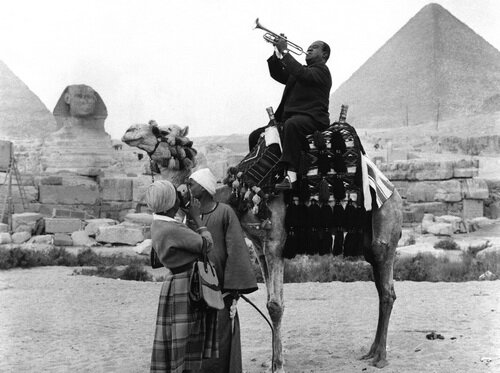How The U.S. Used Black Jazz Musicians As Secret Weapons of The Cold War
Over 60 years ago, America was in the midst of The Cold War, and the government was desperate to curb the spread of Russia’s communist ideologies. Black jazz artists like Louis Armstrong were at the helm of the U.S.’s efforts. Jazz was shipped worldwide as a medium of cultural imperialism, referred to as cultural exchange.
Louis Armstrong plays trumpet for his wife, Lucille, in Egypt. 1961.
During that time, the US State Department sent artists worldwide on what they called public and cultural diplomacy initiatives. The department hoped to win allies during the Cold War by using Black jazz culture—framed as "American" culture abroad.
In typical American scammer fashion, these tours were also a way to manufacture a facade of racial harmony in the states—so interracial jazz bands were orchestrated to tour and play together. Ironically, it was the height of the Civil Rights Movement (the South was still segregated), so many wondered why Black artists would tour the world preaching a gospel that painted America as the best country in the world while Black people in America were treated as subhuman.
Well, Black folks ain’t never been no fools. After the State Department tried to brief him before a performance abroad, trumpeter Dizzy Gillespie said, “I’ve got 300 years of briefing. I know what they’ve done to us, and I’m not going to make any excuses.” Armstrong, too knew the paradox of his participation, so upon his return home, he tackled the stark political differences between Black people and the state in a musical called The Real Ambassadors.
Duke Ellington and Paul Gonsalves smoking Sisha during a Middle East tour in 1963.
All in all, their energy was being put towards keeping communism at bay across “developing” nations. Jazz legends like Duke Ellington, Louis Armstrong, and Dizzy Gillespie were sent to trumpet American "values" into the psyche of folks across Africa and Asia. We continue to save the US repeatedly, and the US continues to exploit us as it always has. But we don’t have to play by their rules. We must work together to beat their systems and fight for our liberation.










